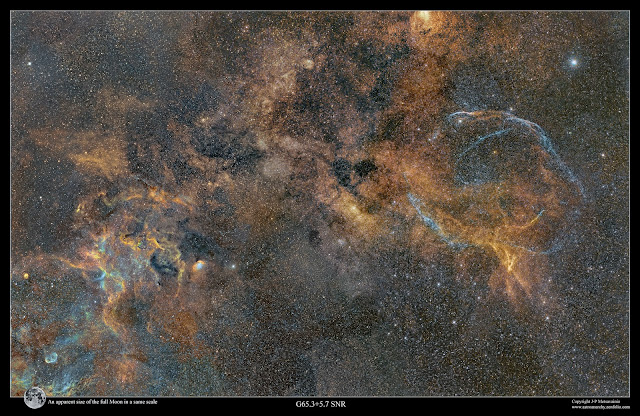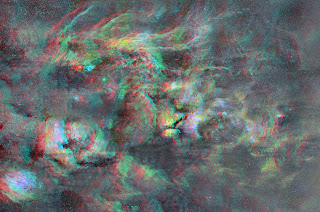COPYRIGHT, PLEASE NOTE
Tuesday, December 15, 2020
Cygnus project, ten years and 500 hours, the grande finale!
Total exposure time is way over 600 hours shot between 2010 and 2020. Some areas of this mosaic panorama required more exposure time than others. There are two large supernova remnants in this mosaic. both are large, diffused and very dim. I have used about 150 hours of exposures for them alone! There are hardly any deep and large enough photos around showing them well.
I have started this imaging project back at 2010. My aim was make a highish resolution mosaic covering the constellation Cygnus. Work like that takes time and patience, especially since I have worked so, that many of the individual sub mosaics or frames can be published as an individual artworks. Here is a poster format presentation about all of longer focal length images used for this mosaic beside actual panels, https://astroanarchy.blogspot.com/2018/11/treasures-of-swan.html
As a result I have now a huge 37 panel (And 58 long focal length sub-panel) mosaic panorama covering 28 x 18 degrees of sky. I have collected photons way over 500 hours during past ten years for this photo. The full size mosaic image has a size of about 25.000 x 15.000 pixels.
A photo of five million stars*
Great Mosaic of Cygnus (2010-2020)
28x18 degrees, 37 + 58 panels and over 600 hours of exposure time
The full size photo is worth to see! (2700 x 1700 pixels)
* I actually counted the stars and in this field of view there are little over five million individual stars
Three supernova remnants, two Wolf Rayet stars and a black hole
Please, click the image for full resolution
You should click the images to see them in full glory, it's worth the effort!
North America and the Pelican Nebula
Original size in mosaic image is 5000 x 2500 pixels
The supernova remnant G65.3+5.7 at top of the mosaic image
A closeup from the supernova remnant G65.3+5.7
The noise is not a noise, just a massive amount of stars
The blog post with technical details can be seen here, https://astroanarchy.blogspot.com/2020/10/the-tulip-nebula-in-cygnus-sh2-101.html
Cirrus of Cygnus
Blog post about this photo, https://astroanarchy.blogspot.com/2020/12/cirrus-of-cygnus-and-supernova-remnant.html
Click for a large image
NOTE I recalculated the total exposure time and it's actually way over 600 hours.
Here is a poster format presentation and a list all of longer focal length images used for this mosaic beside the actual panels, https://astroanarchy.blogspot.com/2018/11/treasures-of-swan.html
Beside three supernova remnants there are two Wolf Rayet stars with outer shell formations. NGC 6888, the Crescent Nebula at center of the image and the WR 134, it can be seen as a blue arch just right from the Crescent Nebula, near the Tulip nebula.
Next to the Tulip Nebula lays a Black hole Cygnus X-1, it's marked in small closeup image of the Tulip Neula at center right in orientation image above.
Constellation Cygnus is an endless source of celestial wonders, both scientifically and aesthetically. For me, as an visual artist, this are of night sky is very inspiring There are endless amount of amazing shapes and structures, I can spend rest of my life just shooting images from this treasury.
A funny anecdote
The answer was; "If you think about the swan, I just pointed out the anatomically correct location"
Sunday, November 27, 2011
A collection of "Sub mosaics" of Cygnus mosaic
A series of panoramic mosaics.
Mosaics are done from the material used in my large, eight panel, mosaic of Cygnus Nebulae.
The "Cirrus area" of Cygnus
From North America & Pelican Nebulae to the "Cirrus area" at Right.
Four panels mosaic from North America & Pelican Nebulae to Crescent Nebula.
Three panel mosaic from "Cirrus area" of Cygnus to the Tulip Nebula at upper Right.
Two panel mosaic from Butterfly to the Crescent Nebula.
Two panel mosaic from Butterfly to the "Cirrus area" of Cygnus.
Couple of panoramas in natural color palette from narrowband channels
Two panel mosaic from Butterfly to the "Cirrus area" of Cygnus.
From North America & Pelican Nebulae to the "Cirrus area" at Right.
The "Cirrus area" of Cygnus
Three panel mosaic from "Cirrus area" of Cygnus to the Tulip Nebula at upper Right.
I made mosaic panoramas above, since I now have several over lapping images from constellation Cygnus.
The massive resolution, eight panel, mosaic of Nebulae in Cygnus can be seen in this blog post:
http://astroanarchy.blogspot.com/2011/11/cygnus-project-grande-finale.html
Eight panel mosaic of Cygnus, used for the panoramas
An eight panel mosaic of Nebulae in constellation Cygnus.
All panoramic images above are made from this material.
A very large, 7,5 meg and 3000x2000 pixel, version can be seen HERE.
Friday, December 9, 2011
Cygnus mosaic, 18-panels and 22 x 14 degrees of sky
Even larger, 3500 x 2200 pixels and ~10Mb, image can be seen from HERE.
- Original size for the 18 panels mosaic ~15.000 x10.000 pixels
- Resolution 5,5 arch seconds / pixel
- Image center, RA 20h 27s, Dec 43d 30m 45s
- Area of this image is about 22 x14 degrees of sky.
- Full Moon has an angular diameter of 0,5 degrees, it fits to the area of this image about 1230 times!
A detail from the North America and Pelican Nebulae area.
More closeups in this blog post:
http://astroanarchy.blogspot.com/2011/11/cygnus-project-grande-finale.html
A Gray scale image of Hydrogen alpha emission
The Tulip nebula, a wide field image:
http://astroanarchy.blogspot.com/2011/01/tulip-nebula-sh2-101-wide-field-closeup.html
Sunday, November 18, 2018
Treasures of the Swan
This area of sky is full of wonders, emission nebulae, supernova remnants, planetary nebulae, complex networks of dark nebulae and many other objects and cosmic phenomenon. I think I can spend rest of my life by shooting this nebula complex, it's a source of never ending wonders and visual treasures.
Treasures of Cygnus
Please, click the image to see a large version, it's worth it!
(3300 x 5500 pixels)
A location for each photo is marked at the large mosaic image of constellation Cygnus at center.
- The Tulip nebula (APOD), https://astroanarchy.blogspot.com/2014/10/tulip-nebula-finalized-project.html
- Clouds of Swan, https://astroanarchy.blogspot.com/2018/10/clouds-of-swan.html
- The Crescent nebula (APOD), https://astroanarchy.blogspot.com/2011/01/ngc-6888-crescent-nebula-reprocessed.html
- Dark filaments of Cygnus, https://astroanarchy.blogspot.com/2016/11/a-detail-photo-of-dark-filaments-in.html
- The Pelican nebula, https://astroanarchy.blogspot.com/2014/10/first-light-image-for-my-new.html
- The Great Wall of Cygnus, https://astroanarchy.blogspot.com/2016/12/a-panoramic-view-to-north-america-nebula.html
- Dark Filaments of Cygnus, https://astroanarchy.blogspot.com/2016/12/dark-filaments-in-cygnus-project.html
- NGC 7000 details, https://astroanarchy.blogspot.com/2016/11/a-little-different-view-to-north.html
- Sharpless 119, https://astroanarchy.blogspot.com/2017/12/sharpless-119-in-cygnus-project.html
- Filaments of Cygnus, https://astroanarchy.blogspot.com/2015/10/filaments-of-cygnus-project-continues.html
- Filaments of Cygnus, https://astroanarchy.blogspot.com/2015/10/filaments-of-western-cygnus.html
- Sharpless 115, https://astroanarchy.blogspot.com/2014/11/sharpless-115-and-planetary-nebula.html
- Sharpless 112, https://astroanarchy.blogspot.com/2015/10/sharpless-112-sh2-112-in-cygnus.html
- Filaments of Cygnus, https://astroanarchy.blogspot.com/2015/11/filaments-of-cygnus.html
- The Propeller Nebula, https://astroanarchy.blogspot.com/2014/11/dwb-111-propeller-nebula.html
- Cygnus Shell, W63, (APOD) https://astroanarchy.blogspot.com/2018/10/a-very-rare-photo-cygnus-shell.html
- LBN 251, 239 and IC 1311, https://astroanarchy.blogspot.com/2018/10/this-new-photos-shows-lbn-251-and.html
- PN PM 1-320, https://astroanarchy.blogspot.com/2015/11/more-filaments-of-cygnus-and-couple-of.html
- LBN 243, https://astroanarchy.blogspot.com/2018/11/lbn-243.html
- W 134, https://astroanarchy.blogspot.com/2017/11/wr-134-ring-nebula-area-as-mosaic-image.html
- The Central Cygnus, https://astroanarchy.blogspot.com/2017/01/bright-nebulae-of-central-cygnus-eleven.html
- Pelican nebula panorama, https://astroanarchy.blogspot.com/2018/11/pelican-nebula-panorama.html
- Dark Clouds of Cygnus, https://astroanarchy.blogspot.com/2018/11/dark-clouds-of-cygnus.html
- The Great Wall of Cygnus panorama, https://astroanarchy.blogspot.com/2018/11/panoramic-photo-of-great-wall-of-cygnus.html
Tuesday, November 29, 2011
Cygnus Mosaic is getting large, 18 panels now
The "Chinese Dragon Nebula"
The noise in a background, is not a noise but countless number of stars!
- Original size for the 18 panels mosaic 14.000 x 9000 pixels
- Resolution 5,5 arch seconds / pixel
- Image center, RA 20h 27s, Dec 43d 30m 45s
- Area of this image is about 22 x14 degrees of sky.Full Moon has an angular diameter of 0,5 degrees, it fits to the area of this image about 1230 times!Start of the Cygnus project
I started the Cygnus mosaic project by shooting a three panel mosaic from the "Cirrus area"Blog post can be seen here: http://www.astroanarchy.blogspot.com/2011/11/cirrus-of-cygnus-project-finalized.htmlImage in mapped colors, H-a = Green, S-II = Red and O-III = BlueThe second phase was an eight panel mosaic. The blog post can be seen from here:Eight panel mosaic. This image gives an idea, how the large mosaic will look in colors.
Technical details for the 18 panel mosaic
NOTE.
No star or noise reduction, nor sharpening, are used.
Monday, February 1, 2021
This gigapixel mosaic has about 1000 exposure hours between 2010 - 2021
Over a ten years and about 1000 hours of exposures, the image spans 82 x 20 degrees of sky at resolution of 17.000 x 72.000 pixels (Over a gigapixel)
Individual frames are shot between 2010 and 2021, there are total 168 images stitched together! There are more than ten million stars visible in this mosaic image!
Orientation in the sky
Click for a large image
My processing workflow is very constant so very little tweaking was needed between the mosaic frames. Total exposure time is way over 900 hours. Some of the frames has more exposure time, than others. There are some extremely dim objects clearly visible in this composition, like a extremely dim supernova remnant W63, the Cygnus Shell. It lays about six degrees up from North America nebula and it can be seen as a pale blue ring. I spent about 100 hours for this SNR alone. An other large and faint supernova remnant in Cygnus can be seen at near right edge of the image. G65.5+5.7 is as large as more famous Veil nebula. There are over 60 exposure hours for this SNR alone. (Veil SNR is just outside of the mosaic area but can be seen in "Detail" image above.)
The supernova remnant G65.3+5.7
A closeup from the supernova remnant G65.3+5.7
The noise is not a noise, just a massive amount of stars
The blog post with technical details can be seen here, https://astroanarchy.blogspot.com/2020/10/the-tulip-nebula-in-cygnus-sh2-101.html
Cirrus of Cygnus and the supernova remnant W63
Blog post about this photo, https://astroanarchy.blogspot.com/2020/12/cirrus-of-cygnus-and-supernova-remnant.html






























































